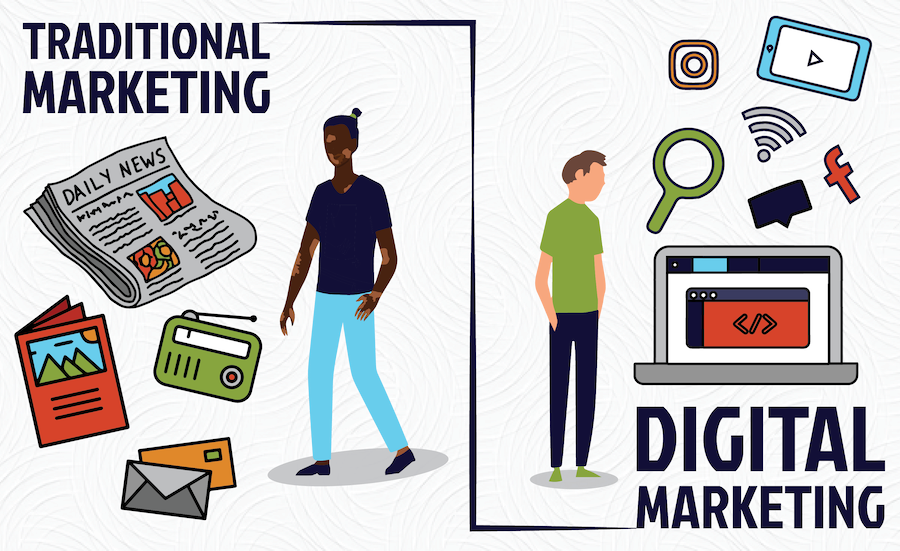Explore the transformative impact of digital marketing on traditional advertising. Learn how shifting consumer behavior, the rise of digital channels, and the integration of both strategies are reshaping the marketing landscape, driving engagement, and redefining brand communication in today's digital-first world.
The Influence of Online Promotion on Conventional Advertising.
In the marketing realm there has been a shift in the last 20 years, due to the growth of technology. Online marketing has become a player changing how brands interact with consumers and transforming the methods used in advertising. This article delves into how online marketing is impacting advertising by looking at consumer behavior the benefits of platforms and the future of marketing. In a world.
Understanding Traditional Advertising
Traditional advertising includes forms of media, like TV, radio, print media and outdoor billboards that have been used for many years. These platforms have been the way for brands to connect with audiences by using messages to create awareness and boost sales. Traditional advertising usually requires a investment of time with marketers using creative messages and eye catching visuals to grab consumers attention.
However the effectiveness of advertising has decreased due, to changing consumer preferences and advancements in technology. Nowadays consumers prefer experiences making generic messaging less impactful. Additionally the growth of technology has given consumers control over what they see leading to a reduced reach and influence of advertising.
The Rise of Digital Marketing
Digital marketing is the process of promoting goods or services through channels such as media, search engines, email and websites. With the surge in internet usage brands have increasingly turned to platforms to connect with consumers in real time. This shift is driven by factors like the widespread use of smartphones the rise of media and the ability to gather and analyze data to shape marketing approaches.
One major advantage of marketing is its ability to target specific audiences. Unlike advertising, which casts a net digital marketing enables brands to segment their audiences based on demographics, behaviors and interests. This targeted approach leads to messaging and higher conversion rates. For example a brand can utilize ads on media to reach users who have previously expressed interest in similar products, thereby increasing the likelihood of engagement and purchase.
Changing Consumer Behavior
The shift towards marketing has come hand in hand, with significant changes in how consumers behave. Nowadays consumers are more knowledgeable connected and empowered than ever before. They actively search for information about products and services online using search engines and social media to explore options before making a purchase. This shift in behavior has diminished the impact of advertising which often relies on interruptive messages rather than engaging content.
Moreover the increasing use of ad blocking technology has added complexity to the realm of advertising. People are using tools to block ads making it harder for brands to grab their attention. In contrast marketing approaches that prioritize creating valuable content like informative blog posts, captivating social media updates and entertaining videos tend to resonate better with audiences. This focus on content helps build connections, between brands and consumers fostering loyalty and encouraging repeat business.
The Cost-Effectiveness of Digital Marketing
One notable benefit of marketing is its cost efficiency compared, to traditional forms of advertising. Traditional methods often demand budgets for creation and placement. Digital marketing provides a range of options that suit various financial capacities. For instance businesses can implement pay per click (PPC) campaigns on search engines or social media platforms where they only incur costs, for actual clicks or impressions generated by their ads.
This adaptability empowers small businesses to compete with larger brands by targeting audiences without overspending. Additionally digital marketing efforts can be modified based, on performance metrics allowing marketers to fine tune their approaches in time. Conversely traditional advertising often involves lead times and substantial investments with limited room for adjustments once the campaign is underway.
Combining Digital and Traditional Advertising.
Although digital marketing presents challenges, to advertising both methods can coexist and enhance one another. Many effective marketing initiatives today combine both digital and traditional tactics to optimize their reach and impact. For example brands can utilize media to generate awareness while guiding audiences towards platforms for deeper engagement and interaction. A prime illustration of this integration is the incorporation of commercials to promote media hashtags. Brands motivate viewers to join discussions by sharing their experiences or interacting with specific campaigns. This approach broadens the scope of advertising while directing traffic to channels offering a brand experience.
The Future of Marketing
As the landscape of marketing evolves the future of advertising seems to hinge on its adaptability, to shifting consumer behaviors and technological progress. To stay competitive brands must embrace platforms and incorporate them into their marketing strategies. This may involve reallocating budgets towards focusing on digital channels investing in data analytics for understanding audience preferences and exploring technologies like reality (AR) and reality (VR) to craft experiences.
Additionally ethical considerations surrounding privacy and consumer trust will significantly influence the marketing landscape. With growing awareness of data collection practices brands must prioritize transparency and ethics in their digital marketing endeavors. Building trust will be crucial for nurturing lasting relationships with consumers and ensuring the success of marketing campaigns.
Conclusion
The influence of marketing, on traditional advertising is significant and widespread. With changing consumer habits brands need to adjust to stay relevant and competitive. Although traditional advertising still has its merits digital marketing provides unmatched opportunities for reaching out to customers being cost effective and optimizing campaigns in time. By combining both digital and traditional approaches brands can develop marketing strategies that resonate with audiences and deliver impactful outcomes. As the marketing landscape evolves those who can skillfully navigate this ever changing terrain by utilizing the strengths of both methods to engage consumers meaningfully will be the ones who succeed in the future.
